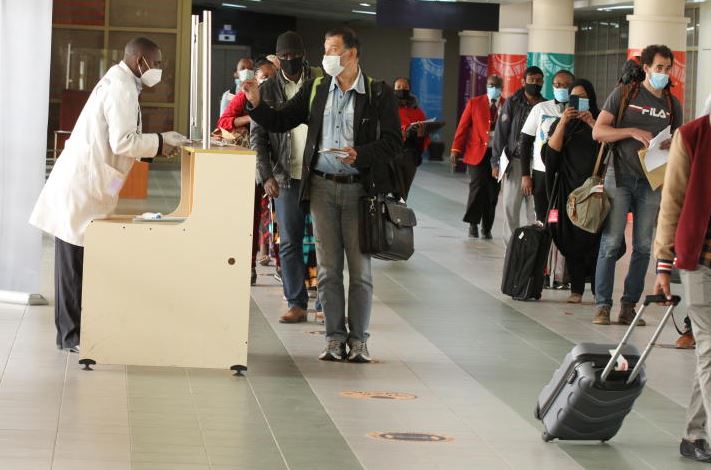
Passengers arrive at JKIA after International flights resumed. [Elvis Ogina, Standard]
Back in July 2020 when the government started easing restrictions it had put in place to control the spread of Covid-19, a number of Kenyans took time out to travel.
One popular game reserve reported that while there was an influx of local tourists after the lockdown was lifted, there were no signs of significant foreign tourists at the time.
The lack of international visitors is, however, something that the industry will have to contend with for some time, with domestic tourists among their few options for staying afloat.
Even as the economic recovery offers a glimpse of hope, it is perhaps towards the end of this year that the country might see a substantial increase in international arrivals.
The industry faces the challenge of increasing political noise, currently seen in the campaigns for the Building Bridges Initiative and likely to transit to campaigns for next year’s General Election.
A January 2021 survey by the Central Bank of Kenya that sampled views from different industry players showed that while there were expectations of rebound this year across all sectors pegged on the Covid-19 vaccine, tourism stakeholders expressed concerns over the heightened political activity and slow rollout of the vaccines.
Slow recovery
The expected slow recovery in the international tourism segment and the politics, which traditionally slows down the sector, leaves the industry with the local tourist whose monetary contribution might not be anywhere near what moneyed foreigners spend.
Tourism is the second largest foreign exchange earner for Kenya after diaspora remittances, with earnings in 2019 standing at Sh164 billion. This is expected to be substantially lower in 2020 and this year.
“Every hotelier or tour company must embrace domestic and regional tourism. Any player who has not embraced local tourism today will be left behind,” said Mohammed Hersi, chair of the Kenya Tourism Federation, a private sector umbrella body for tourism sector lobbies.
“The hotels which have taken up domestic tourism are the ones who are doing well. Embracing domestic tourism is easy, all Kenyans want is good service, good price and to treated with dignity.”
Hersi, however, noted that the domestic tourism segment should not be an afterthought or an area to tap into during crises. It should stand on its own and get preference with or without international travelers, he said.
“It is not about one replacing the other, we need both domestic and international tourism to walk alongside each other. It is a segment of its own and should be serviced throughout the year,” he told The Standard in an interview.
Hersi is a hotelier and currently director of operations at Pollman Tours and Safaris, and Baobab Beach Resort.
“It is no longer a school holiday affair as was the case a few years ago. We see a lot of travels, for instance to the Coast, over the weekends because we have Madaraka Express and a number of low-cost carriers that fly to Malindi, Diani and Mombasa,” he said.
Tourism is also banking on increasing visits from other African countries, with a 2017 directive by President Uhuru Kenyatta that Africans visiting Kenya would get visas on arrival.
The scrapping of stringent visa rules has, however, not translated to an increase in the number of tourists from the continent.
In 2017, for instance, 532,000 Africans visited Kenya and while this went up to 619,000 in 2018, the numbers dropped to 587,000 in 2019, according to data by the Kenya National Bureau of Statistics.
Hersi said regional tourism is an area with huge potential that Kenya can develop to grow revenues as well as reduce over-reliance on traditional tourist source markets.
Fred Kaigua, the chief executive of Kenya Association of Tour Operators said Kenya’s tourism industry has for years focused on international tourists.
“The industry is definitely not doing well,” he told The Standard. “The business model for the tourism industry is heavily international. When we do not have international tourists coming in, you find that most people will be in bad shape.”




No comments :
Post a Comment